Page 223 of 380
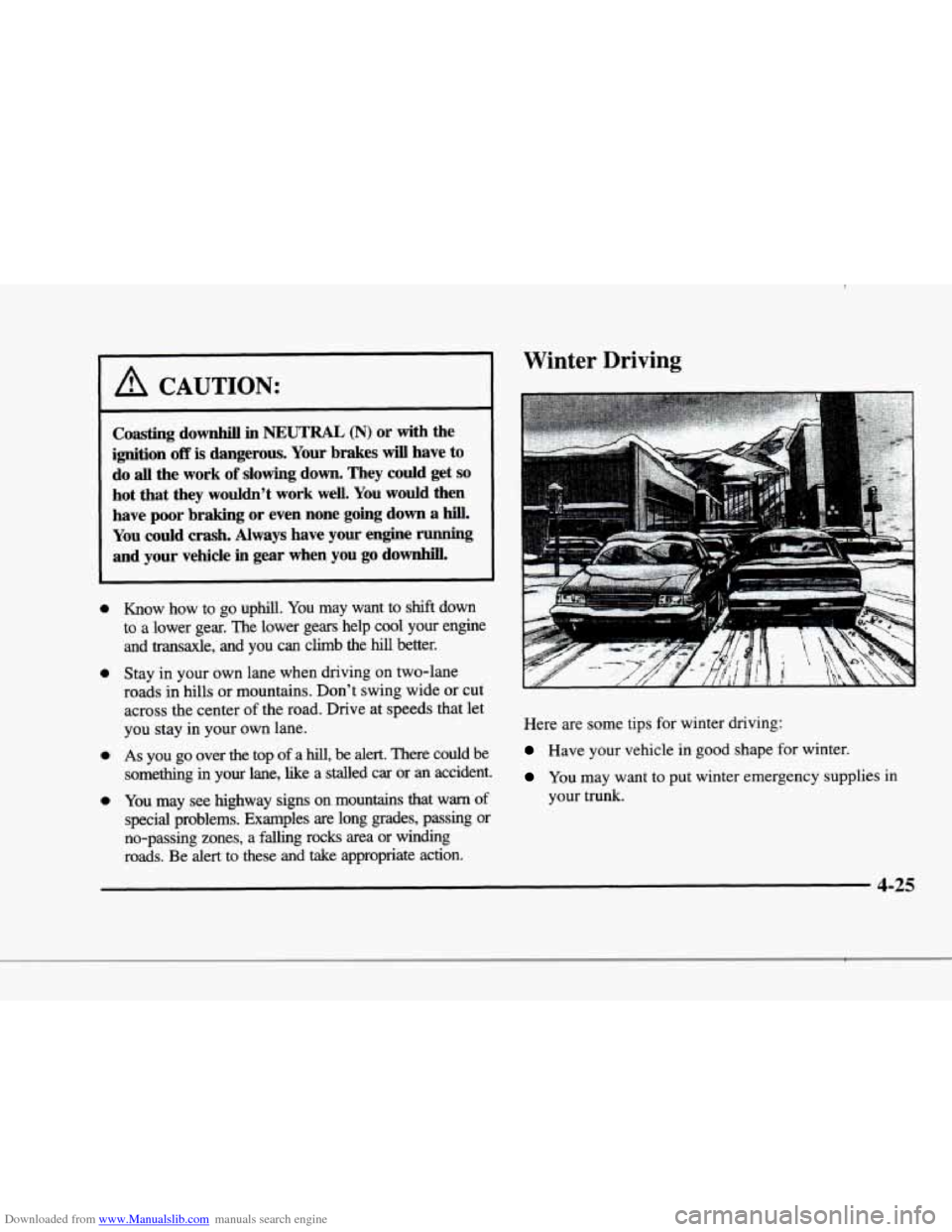
Downloaded from www.Manualslib.com manuals search engine L
r
I
r i
r I
I A CAUTION:
Coasting downhill in NEUTRAL (N) or with the
ignition
off is dangerous. Your brakes will have to
do all the work of slowing down. They could get so
hot that they wouldn’t work well. You would then
have poor braking or even none going down
a hill.
You could crash. Always have your engine running
and your vehicle in gear when you go downhill.
f I
i
Know how to go uphill. You may want to shift down
to a lower gear. The lower gears help cool your engine
and transaxle, and you can climb the
hdl better.
Stay in your own lane when driving on two-lane
roads in hills or mountains. Don’t swing wide or cut
across the center of the road. Drive at speeds that let
you stay in your own lane.
As you go over the top of a hill, be alert. There could be
something in your lane, like a stalled car or an accident.
You may
see highway signs on mountains that warn of
special problems. Examples are long grades, passing or
no-passing zones, a falling rocks area or winding
roads. Be alert to these and take appropriate action.
Winter Driving
Here are some tips for winter driving:
Have your vehicle in good shape for winter.
You may want to put winter emergency supplies in
your trunk.
~ 4-25 P i I
Page 228 of 380

Downloaded from www.Manualslib.com manuals search engine Loading Your Vehicle
[@ OCCUPANTS VEHICLE CAP, WT.
TIRE-LOADING INFORMATION
KG LBS. FRT. CTR. RR. TOTAL
MAX. LOADING
& GVWR SAME AS VEHICLE
CAPACITY WEIGHT XXX COLD TIRE
TIRE
SIZE SPEED PRESSURE
RTG PSL’KPa
FRT.
RR.
SPA.
IF TIRES ARE HOT, ADD 4PS1!28KPa
SEE OWNER‘S MANUAL FOR ADDITlONAL
\INFORMATION
Two labels on your vehicle show how much weight it
may properly carry. The Tire-Loading Information label
found
on the driver’s door tells you the proper size,
speed rating and recommended inflation pressures for
the tires on your vehicle. It also gives you important
information about
the number of people that can be in
your vehicle and the total weight that
you can carry.
This weight is called the Vehicle Capacity Weight and
includes the weight
of all occupants, cargo and all
options not installed in the factory.
MFD BY GENERAL MOTORS CORP
DATE GVWR
GAWR FRT GAWR RR
THIS VEHICLE CONFORMS TO ALL APPLI-
CABLE US. FEDERAL MOTOR VEHICLE
SAFETY,
BUMPER, AND THEFT PREVENTION
STANDARDS
IN EFFECT ON THE DATE OF
MANUFACTURE SHOWN ABOVE.
The other label is the Certification label. found on the
rear edge
of the drives’s door. It tells you the gross
weight capacity
of your vehicle, called the GVWR
(Gross Vehicle Weight Rating). The GVWR includes
the weight
of the vehicle, all occupants, fuel and cargo.
Never exceed
the GVWR for your vehicle, or the Gross
Axle Weight Rating (GAWR)
for either the front or
rear axle.
If you do have a heavy load, you should spread it out.
Don’t carry more than
176 lbs. (80 kg) in your trunk.
Page 229 of 380
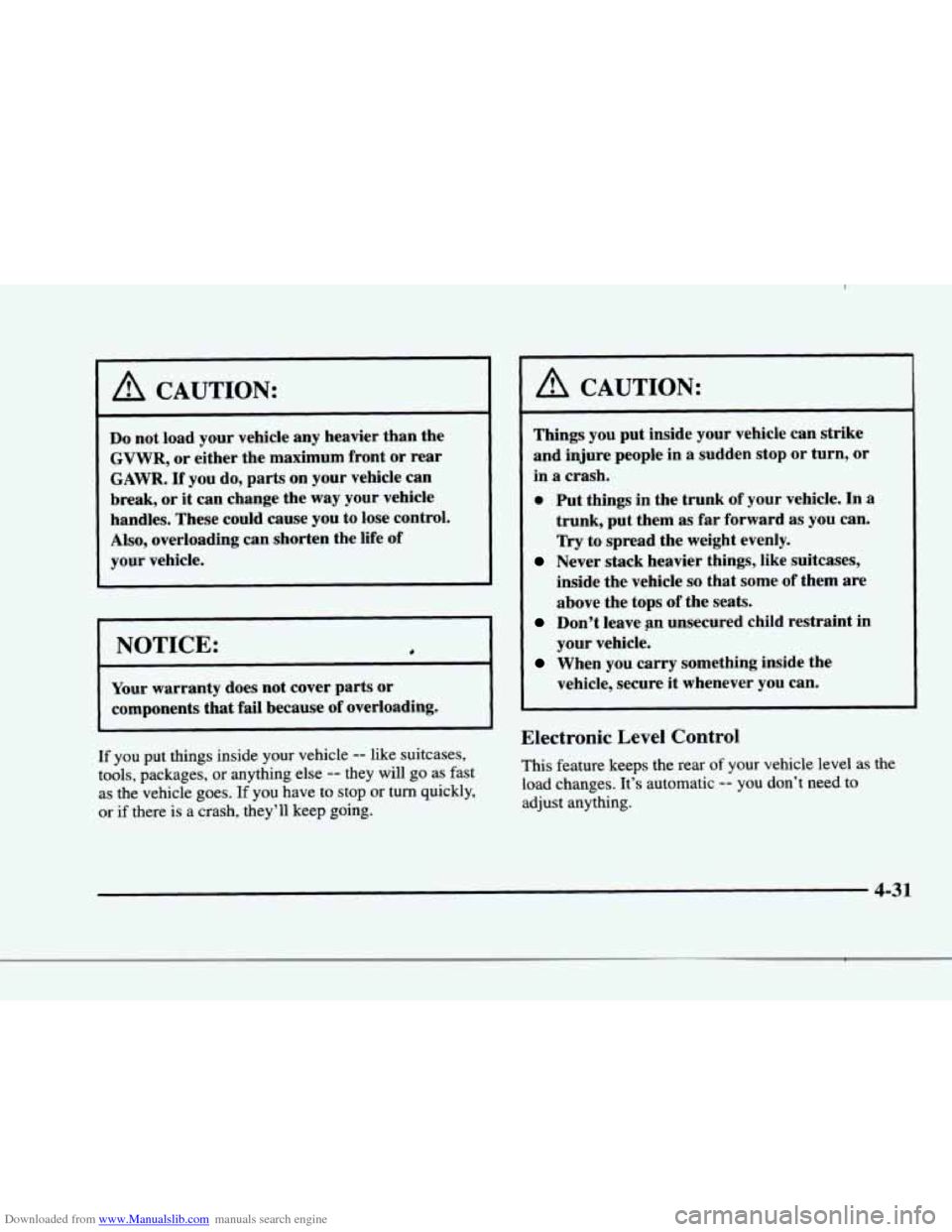
Downloaded from www.Manualslib.com manuals search engine b
b !
f-
r
i
r
f
~ ~~
A CAUTION:
Do not load your vehicle any heavier than the
GVWR, or either the maximum front or rear
GAWR. If you do, parts on your vehicle can
break, or it can change the way your vehicle
handles. These could cause you to lose control.
Also, overloading can shorten the life of
your v,ehicle.
I NOTICE:
Your warranty does not cover parts or
components that
fail because of overloading.
If you put things inside your vehicle -- like suitcases,
tools, packages, or anything else
-- they will go as fast
as the vehicle goes.
If you have to stop or turn quickly,
or if there is a crash, they’ll keep going.
A CAUTION:
~~
Things you put inside your vehicle can strike
and injure people in a sudden stop or turn, or
in
a crash.
0 Put things in the trunk of your vehicle. In a
trunk, put them as far forward as you can.
Try to spread the weight evenly.
inside the vehicle
so that some of them are
above the tops of the seats.
Don’t leave an unsecured child restraint in
your vehicle.
When you carry something inside the
vehicle, secure it whenever you can.
Never stack heavier things, like suitcases,
Electronic Level Control
This feature keeps the rear of your vehicle level as the
load changes. It’s automatic
-- you don’t need to
adjust anything.
4-31
Page 265 of 380
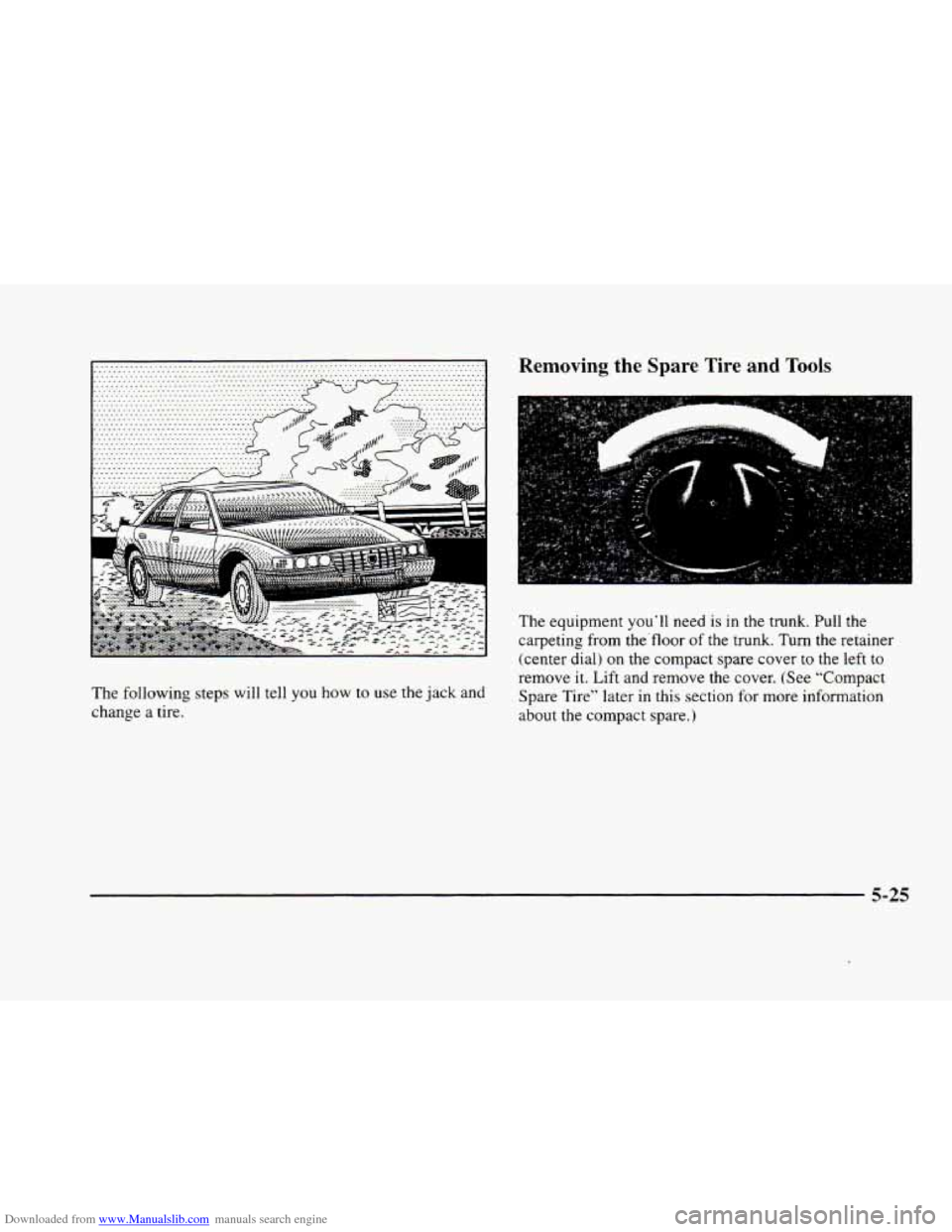
Downloaded from www.Manualslib.com manuals search engine ........................................................................\
........ ........................................................................\
........ ........................................................................\
........ ................ ..................................................... -. .................. ............................................. .................. ........................................... .......................................... ........................................... ................... .....................
................... ............................................
The following steps will tell you how to use the iack and
change a tire.
Removing the Spare Tire and Tools
The equipment you’ll need is in the trunk. Pull the
carpeting from the‘floor
of the trunk. Turn the retainer
(center dial)
on the compact spare cover to the left to
remove it. Lift and remove the cover. (See “Compact
Spare Tire” later in this section for more information
about the compact spare.)
5-25
Page 266 of 380
Downloaded from www.Manualslib.com manuals search engine I
Lift up the tire to remove it from the trunk. Turn the nut holding the jack and wheel wrench to the
left and remove it. Then remove the jack and wrench.
5-26
Page 272 of 380
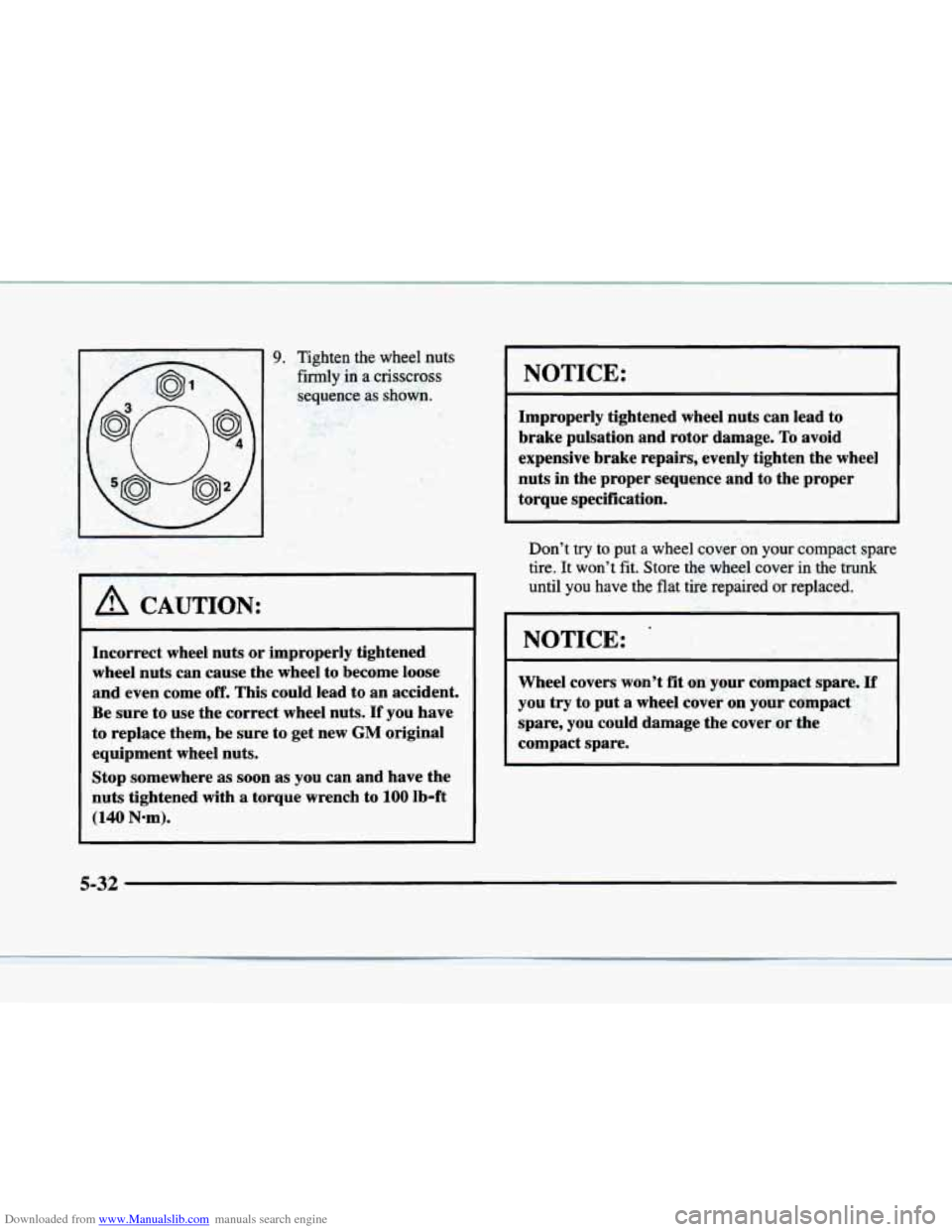
Downloaded from www.Manualslib.com manuals search engine 9. Tighten the wheel nuts
firmly
in a crisscross
sequence as shown.
A CAUTION:
Incorrect wheel nuts or improperly tightened
wheel nuts can cause the wheel to become loose
and even come
off. This could lead to an accident.
Be sure to use the correct wheel nuts.
If you have
to replace them, be sure to get new
GM original
equipment wheel nuts.
Stop somewhere as soon as you can and have the
nuts tightened with a torque wrench to
100 Ib-ft
(140 Nom).
NOTICE:
Improperly tightened wheel nuts can lead to
brake pulsation and rotor damage.
To avoid
expensive brake repairs,
evenly tighten the wheel
nuts in the proper sequence and to the proper
torque specification.
Don’t try to put a wheel cover on your compac’ ~ pare
tire. It won’t fit. Store the wheel cover in
the trunk
until you have the flat tire repaired or replaced.
NOTICE:
-~
Wheel covers won’t fit on your compact spare. If
you try to put a wheel cover on your compact
spare, you could damage the cover.
or the
compact spare.
5-32
Page 273 of 380
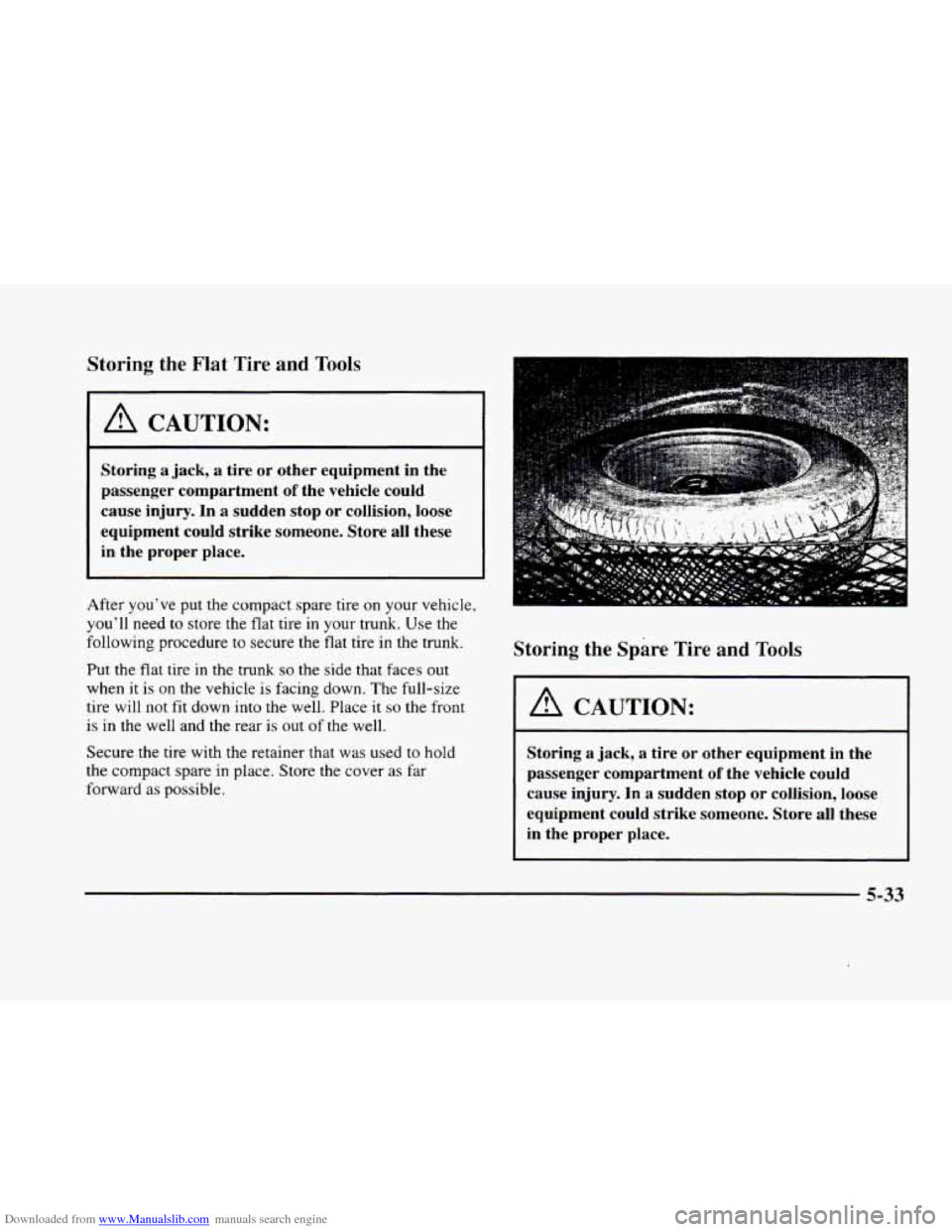
Downloaded from www.Manualslib.com manuals search engine Storing the Flat Tire and Tools
1 A CAUTION:
~~
Storing a jack, a tire or other equipment in the
passenger compartment
of the vehicle could
cause injury. In
a sudden stop or collision, loose
equipment could strike someone. Store
all these
in the proper place.
After you've put the compact spare tire on your vehicle,
you'll need to store the flat tire in your trunk. Use the
following procedure to secure the flat tire in the trunk.
Put the flat tire in the trunk
so the side that faces out
when
it is on the vehicle is facing down. The full-size
tire will not fit down into
the well. Place it so the front
is in the well and the rear
is out of the well.
Secure the tire with
the retainer that was used to hold
the compact spare in place. Store the cover as far
forward as possible.
Storing the Spare Tire and Tools
A CAUTION:
Storing a jack, a tire or other equipment in the
passenger compartment
of the vehicle could
cause injury.
In a sudden stop or collision, loose
equipment could strike someone. Store
all these
in the proper place.
5-33
Page 286 of 380
Downloaded from www.Manualslib.com manuals search engine The cap is behind a hinged door on the driver's side of
your vehicle.
The fuel door release
is
located on console and on
the Remote Keyless Entry
(RKE) transmitter.
An alternate fuel door
release is located inside
of
the trunk on the left hand
side. Pull it to release the
fuel door. While refueling, hang'the
cap
by the tether from the
hook
on the filler door.
To remove the cap, turn it slowly to the left
(counterclockwise). The cap has a spring in it;
if you let
go of the
cap too soon, it will spring back to the right.
6-6